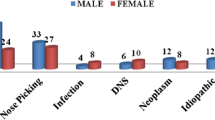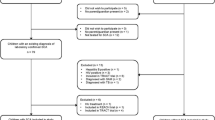Abstract
Epistaxis and alcohol overconsumption are frequently encountered in patients admitted to emergency wards. The aim of the study was to analyze indirect markers of alcohol overconsumption in epistaxis patients and evaluate its role as a risk factor. In a cohort of 510 epistaxis patients indirect markers of alcohol overuse were measured including the mean corpuscular volume (MCV), gamma glutamyltransferase (GGT), aspartate aminotransferase and alanine aminotransferase. The results were compared to the normal findings in literature. Pathologic mean levels of GGT were found in epistaxis patients. Almost 5% had macrocytosis and MCV correlated positively with liver enzyme levels. Platelet counts were negatively correlated with both corpuscular volumes and liver enzymes. Indirect markers of alcohol overconsumption were found to be elevated in epistaxis patients. These results suggest that a subgroup of epistaxis patients overconsumes alcoholic beverages supporting the idea of alcohol abuse being a risk factor in epistaxis. Questioning about drinking habits should be employed and help offered to affected patients.



Similar content being viewed by others
References
Soyka M, Rufibach K, Huber A, Holzmann D (2010) Is severe epistaxis associated with acetylsalicylic acid intake? Laryngoscope 120(1):200–207
Stopa R, Schönweiler R (1989) Causes of epistaxis in relation to season and weather status. HNO 37(5):198–202
Richoux C, Ferrand I, Casalino E, Fleury B, Ginsburg C, Lejoyeux M (2011) Alcohol use disorders in the emergency ward: choice of the best mode of assessment and identification of at-risk situations. Int J Emerg Med 4(1):27
McGarry G, Gatehouse S, Vernham G (1995) Idiopathic epistaxis, haemostasis and alcohol. Clin Otolaryngol Allied Sci 20(2):174–177
Conigrave KM, Davies P, Haber P, Whitfield JB (2003) Traditional markers of excessive alcohol use. Addiction 98(Suppl 2):31–43
Wu A, Chanarin I, Levi AJ (1974) Macrocytosis of chronic alcoholism. Lancet 1(7862):829–831
Seppa K, Heinila K, Sillanaukee P, Saarni M (1996) Evaluation of macrocytosis by general practitioners. J Stud Alcohol 57(1):97–100
Rinck D, Frieling H, Freitag A, Hillemacher T, Bayerlein K, Kornhuber J, Bleich S (2007) Combinations of carbohydrate-deficient transferrin, mean corpuscular erythrocyte volume, gamma-glutamyltransferase, homocysteine and folate increase the significance of biological markers in alcohol dependent patients. Drug Alcohol Depend 89(1):60–65
Sharpe PC (2001) Biochemical detection and monitoring of alcohol abuse and abstinence. Ann Clin Biochem 38(Pt 6):652–664
Cohen JA, Kaplan MM (1979) The SGOT/SGPT ratio—an indicator of alcoholic liver disease. Dig Dis Sci 24(11):835–838
Rumsey SE, Hokin B, Magin PJ, Pond D (2007) Macrocytosis—an Australian general practice perspective. Aust Fam Physician 36(7):571–572
Seppa K, Laippala P, Saarni M (1991) Macrocytosis as a consequence of alcohol abuse among patients in general practice. Alcohol Clin Exp Res 15(5):871–876
Wymer A, Becker DM (1990) Recognition and evaluation of red blood cell macrocytosis in the primary care setting. J Gen Intern Med 5(3):192–197
Folz B, Kanne M, Werner J (2008) Current aspects in epistaxis. HNO 56(11):1157–1165 (quiz 1166)
Simmen D, Heinz B (1998) Epistaxis strategy—experiences with the last 360 hospitalizations. Laryngorhino-otologie 77(2):100–106
Jackson KR, Jackson RT (1988) Factors associated with active, refractory epistaxis. Arch Otolaryngol Head Neck Surg 114(8):862–865
Rosalki SB (1984) Identifying the alcoholic. Contemp Issues Clin Biochem 1:65–92
Latvala J, Parkkila S, Melkko J, Niemela O (2001) Acetaldehyde adducts in blood and bone marrow of patients with ethanol-induced erythrocyte abnormalities. Mol Med 7(6):401–405
Koivisto H, Hietala J, Anttila P, Parkkila S, Niemela O (2006) Long-term ethanol consumption and macrocytosis: diagnostic and pathogenic implications. J Lab Clin Med 147(4):191–196
Aertgeerts B, Buntinx F, Bande-Knops J, Vandermeulen C, Roelants M, Ansoms S, Fevery J (2000) The value of CAGE, CUGE, and AUDIT in screening for alcohol abuse and dependence among college freshmen. Alcohol Clin Exp Res 24(1):53–57
Kaferle J, Strzoda CE (2009) Evaluation of macrocytosis. Am Fam Physician 79(3):203–208
Giannini EG, Testa R, Savarino V (2005) Liver enzyme alteration: a guide for clinicians. CMAJ 172(3):367–379
Aragon G, Younossi ZM (2010) When and how to evaluate mildly elevated liver enzymes in apparently healthy patients. Cleve Clin J Med 77(3):195–204
Spoerke N, Underwood S, Differding J, Van P, Sambasivan C, Shapiro D, Schreiber M (2010) Effects of ethanol intoxication and gender on blood coagulation. J Trauma 68(5):1106–1111
Engstrom M, Schott U, Reinstrup P (2006) Ethanol impairs coagulation and fibrinolysis in whole blood: a study performed with rotational thromboelastometry. Blood Coagul Fibrinolysis Int J Haemost Thromb 17(8):661–665
Conflict of interest
None.
Author information
Authors and Affiliations
Corresponding author
Rights and permissions
About this article
Cite this article
Soyka, M.B., Schrepfer, T. & Holzmann, D. Blood markers of alcohol use in epistaxis patients. Eur Arch Otorhinolaryngol 269, 1917–1922 (2012). https://doi.org/10.1007/s00405-011-1881-7
Received:
Accepted:
Published:
Issue Date:
DOI: https://doi.org/10.1007/s00405-011-1881-7




